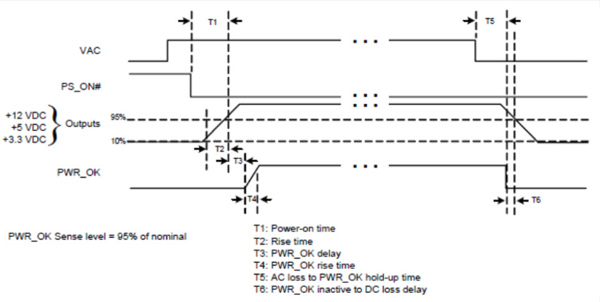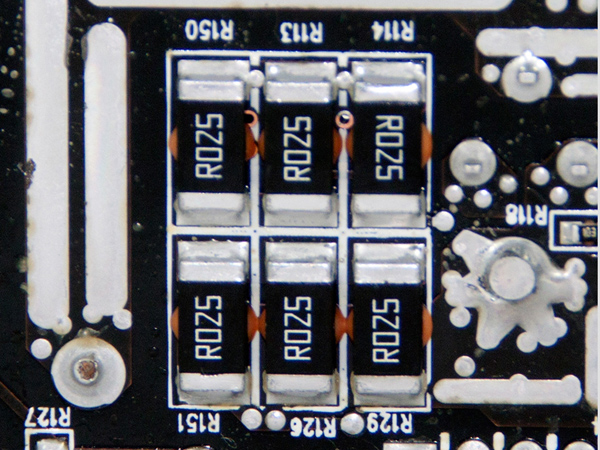PSUs 101: A Detailed Look Into Power Supplies
The objective of this article is to provide detailed information about the most crucial part of a personal computer (PC) system, its power supply unit. Follow us on this journey into PSU territory and we promise that you will gain valuable knowledge.
PSU Protections
In this section, we look at the various protections that a PSU has in order to avoid harm not only to the supply, but also to the system that it feeds with power. Many budget PSUs only have the necessary protections that the ATX specification demands (OCP, SCP, OVP), while higher-end units usually have much more protection.
Power Good Or PWR_OK Signal
As the ATX specification states, the PSU uses a power good or PWR_OK delay signal to indicate that the +5V, +3.3 V and +12V outputs are within the regulation thresholds of the power supply and that sufficient mains energy is stored by the converter to guarantee continuous operation within specification, for at least 17ms under full load (16ms for the AC loss to PWR_OK hold-up time). The PWR_OK delay period according to the ATX spec must be below 500ms and ideally less than 250ms. In any case, it should be equal to or above 100ms.
(OCP) Over-Current Protection
Over-current protection (OCP) is a popular protection found in all PSUs with multiple +12V rails, and in most cases, it also protects the minor rails. OCP kicks in when the current in the rails surpasses a certain limit. The ATX 2.2 specification states that if the load at each tested output rail reaches or exceeds 240VA, then OCP should interfere (paragraph 3.4.4). However, the ATX 2.31 specification omits this limit. In order to bypass it, some manufacturers implemented many virtual +12V rails, with each rail rated at 240VA. However, in most cases, the OCP trigger point was set much higher in order to withstand peak currents that some system components (like graphics cards) could draw.
To implement OCP in a PSU, two things are necessary: shunt resistors and a supervisor IC that supports OCP. The shunt resistors are low-resistance, high-precision resistors used to measure the current at the outputs of a PSU, utilizing the voltage drops those currents create across the resistors. By measuring the number of shunts in a PSU in the area where +12V wires are soldered, we are usually able to find the real number of +12V virtual rails. In some cases, when the manufacturer has initially built the PSU as a multiple +12V rail unit and afterward converted it to a single +12V rail unit, the shunt resistors are simply shorted together.
OVP/UVP (Over Voltage/Under Voltage Protection)
The ATX specification states that the over-voltage protection sense circuitry and reference should reside in packages that are separate and distinct from the regulator control circuitry and reference. So, no single point of fault should be able to cause a sustained over-voltage condition on any output. In other words, all PSUs must have an independent protections circuit and not count solely on the PWM controller to monitor the output voltages. We must also add that UVP is optional since it's not mentioned in ATX specification.
As you might have already guessed, OVP and UVP constantly check the voltages at each rail and kick in when these voltages surpass or go below a trigger point. The ATX spec provides a table with the minimum, nominal and maximum values for the OVP trigger points. The spec includes the 5VSB rail, although it states that OVP protection on this rail is recommended but not required. Below, you will find the corresponding table.
| Output | Minimum (V) | Nominal (V) | Maximum (V) |
|---|---|---|---|
| +12 VDC (or 12V1DC & 12V2DC) | 13.4 | 15 | 15.6 |
| +5 VDC | 5.74 | 6.3 | 7 |
| +3.3 VDC | 3.76 | 4.2 | 4.3 |
| 5VSB (optional) | 5.74 | 6.3 | 7 |
As you can see, the trigger points are way too high. A manufacturer can set OVP to 15.6 for the +12V rails and still be within specification. Imagine 15.6V running through your system components!
Get Tom's Hardware's best news and in-depth reviews, straight to your inbox.
Since UVP trigger points are not covered by the ATX specification, all manufacturers of IC protection circuits are free to set their own.
OPP (Over Power Protection)
The over-power protection (OPP) kicks in when the power we pull from a PSU exceeds its maximum rated capacity. Usually, the manufacturers give a little room for overpowering the PSU, so the OPP threshold is set to 50 to 100W (in some cases even more) above the maximum rated wattage of the PSU. In single +12V rail PSUs, where OCP is meaningless in most cases, OPP takes over its role and shuts down the PSU in case the +12V rail is overloaded.
OTP (Over Temperature Protection)
When the over-temperature protection (OTP) is present, we usually find a thermistor attached to the secondary heat sink (the fan control unit usually uses a thermistor in the same heat sink). The thermistor informs the protections circuit about the temperature of the heat sink, and if this exceeds a specified threshold, then the PSU shuts down. An excessive temperature may be a result of overloading or the cooling fan's failure, so OTP prevents (further) damage to the PSU.
In some cases and because OTP isn't supported by most currently available supervisor ICs, it might be implemented through another method (for instance, by triggering another protection once excess temperature levels are detected in the PSU's internals). We consider OTP to be one of the most crucial protections in any PSU, though many models lack it.
SCP (Short Circuit Protection)
Short circuit protection (SCP) constantly monitors the output rails, and if it finds an impedance of less than 0.1Ω, it immediately shuts down the power supply. In other words, if somehow the output rails are short circuited, then this protection kicks in and shuts down the PSU to prevent damage or fire. According to the ATX 2.31 spec, each +12V rail should have a separate short circuit. This protection is present in almost all contemporary PSUs (at least the branded ones).
Current page: PSU Protections
Prev Page Measuring PSU's Fan RPM Next Page Monitoring Integrated Circuits
Aris Mpitziopoulos is a contributing editor at Tom's Hardware, covering PSUs.

